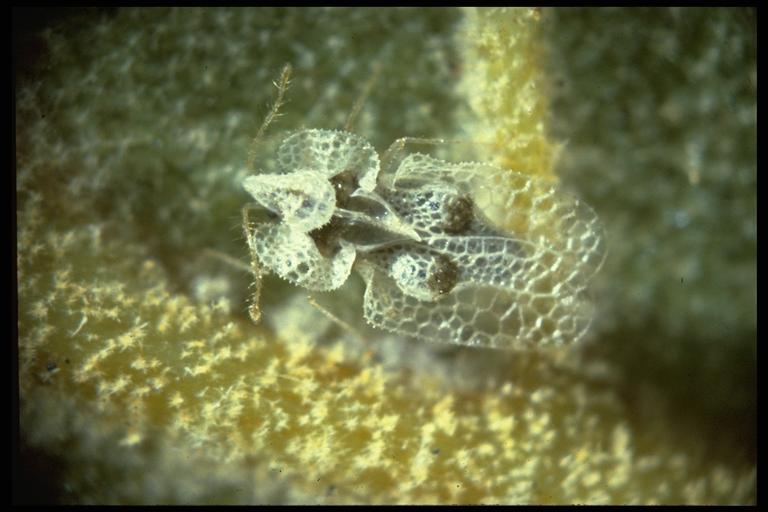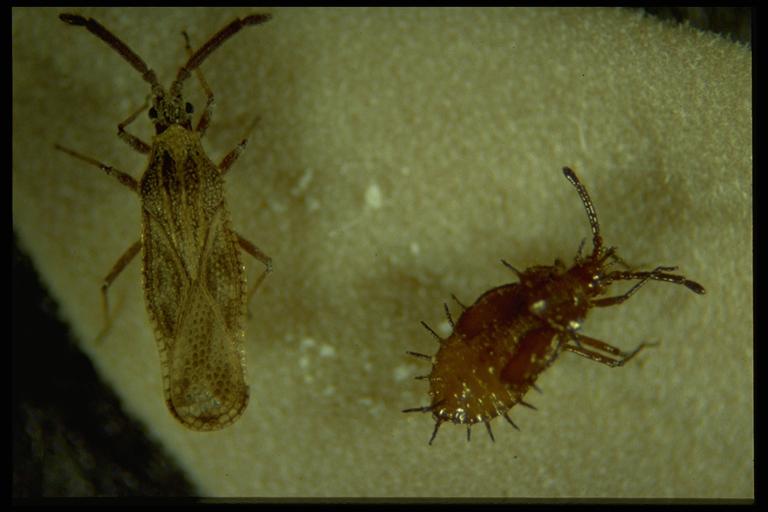
Sycamore lace bug, Corythuca ciliata (Say) (Hemiptera: Tingidae). Photo by Drees.
Common Name: Lace bug
Scientific Name: Corythuca ciliata(Say)
Order: Hemiptera
Description: Adult lace bugs are 1/8 to 1/4-inch long and flattened. The wings and flattened areas behind the head are gauze-like or lace-like and make these insects appear rectangular and whitish or silvery. Nymphal stages lack fully-developed wings and appear oval, marked with blackened areas and adorned with spines.
There are a number of lace bug species in Texas that can become abundant during certain years on particular host plants, such as the oak lace bug, Corythuca arcuata (Say); hawthorne lace bug, Corythuca cydoniae (Fitch) on hawthorn, quince or pyracantha; cotton lace bug, Corythuca gossypii (Fabricius); and lantana lace bug, Teleonemia scrupulosa Stål on lantana and Texas sage (cenizo).

Hawthorne lace bug, Corythuca cydoniae (Fitch) (Hemiptera: Tingidae). Photo by Drees.
Life Cycle:Adults become active in the spring when leaves appear on the host plant. Eggs are glued to the underside of leaves among the hair (pubescence). Nymphs hatching from eggs in a few days and develop through five stages (instars) before becoming adults. Development from egg to adult occurs in about 30 days depending on temperature and other environmental conditions. Three to five generations can be produced annually. Winter is spent as an adult in crevices of host plant bark.
Habitat and Food Source(s), Damage:All life stages occur together on the undersurface of leaves on sycamore, ash and hickory. The upper surface of infested foliage becomes marked with white to yellowish (chlorotic) and later brown (necrotic) speckles. The underside of infested leaves become marked with black varnish-like excrement spots and cast skins of previous developmental stages often remain attached to infested leaves. Lace bug damage to broad-leaved evergreens (azalea, laurel, pyracantha, rhododendron) will be evident for more than a year unless injured foliage is removed. These species overwinter as eggs inserted into leaf veins or cemented to the leaves. Hawthorn lace bug damage to pyracantha usually occurs in mid-July. By late August, most of the leaves may be yellowed (chlorotic) and non-functional.
Pest Status: Common sucking insects that occur on many Texas trees and shrubs, injuring foliage and detracting from the plants beauty; high numbers of lace bugs cause plant stress or even death; medically harmless.

Lantana lace bug, Teleonemia scrupulosa Stål (Hemiptera: Tingidae). Photo by Drees.
For additional information, contact your local Texas A&M AgriLife Extension Service agent or search for other state Extension offices.
Literature: Boring 1979; Johnson and Lyon 1988.